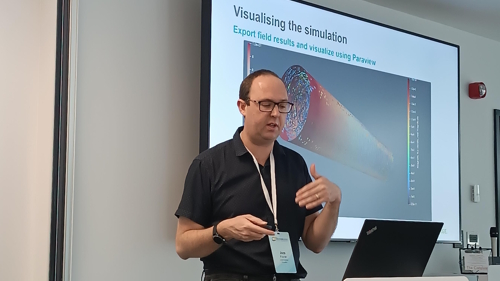
Jaco Fourie presenting at the IEEE Sensors Application Symposium in Newcastle Upon Tyne, in the United Kingdom
How do you train AI to detect foreign objects in food processing pipes when it’s too expensive, time-consuming, and fundamentally impractical to do that training in a working processing plant?
That’s the problem the research team developing a new electromagnetic imaging method for food processing faced as they tried to put their prototype sensor through its paces.
The five-year project is led by Bill Heffernan, Principal Research Engineer at the University of Canterbury, with a team that includes Lincoln Agritech Principal Scientist Jaco Fourie.
New Zealand’s food and beverage manufacturing industry is worth $12.4 billion in exports. Quickly and reliably detecting foreign objects during food processing is important both directly for food safety and to avoid reputational damage.
It’s also problematic; most existing sensors are based on mechanical separation, metal detection, X-ray technology, or near-infrared sensors. But all these methods have their drawbacks – for example X-ray devices can only discern materials of different density, so cannot detect, for example, rubber O-rings in cream-cheese.
This MBIE-funded project is developing an electromagnetic sensor, which detects foreign objects by measuring differences in conductivity between them and the materials they are flowing in (such as milk, ice-cream, cheese, or even sausage mix). Unlike other sensors, it can work for any foreign object that has a different conductivity to the medium it is flowing in.
The team has developed a laboratory prototype, but to be useful to food processors, sensors need to be able to operate at speed, for many different foreign objects.
And so back to the question – how do you train them to do that? The answer, says Jaco, is maths and simulation.
“What would happen if there was a 5mm rubber piece flowing through the pipe?” Jaco asks. “We’ve got some maths that can predict that – and predict what would happen for all manner of foreign objects in the pipe.”
By using that mathematical process, known as the finite element method, to simulate sensor readings for foreign objects of different materials and sizes, the team has been able to produce large quantities of data to train the sensor’s AI.
Jaco recently presented a paper on their simulation method, at the IEEE Sensors Application Symposium in Newcastle Upon Tyne, in the United Kingdom. Other team members also presented papers describing the necessary practical electronics to realise the sensing technique, and comparisons between measured and simulated results.
They are working with seven major New Zealand food producers, in milk, cream, cheese, ice-cream, and meat processing sectors to ensure that the sensors they develop meet the industry’s need.
The team also delivered a paper at the IEEE TENSYMP Conference in Christchurch reporting the simulation and laboratory testing of a very simple sensor, based on the same technology, embedded in a recirculating flow rig with flow speeds of around 2 m/s, as used in the dairy industry.
They are looking at spinning off this simpler “minimum viable product”, which several potential funders/investors have expressed interest in. It may be coming to a factory near you, soon.


